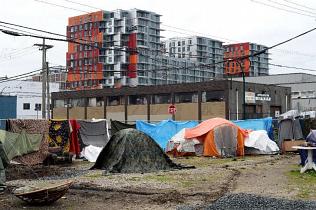House this? Federal housing strategy targets poorest Canadians
B.C. housing advocates are lauding the federal government’s new national housing strategy, which promises $40 billion over the next 10 years directed towards the lowest-income Canadians.
“Today we’re proud to say: we’re back,” Canda’s federal minister of families, Jean-Yves Duclos, said during a press conference in Vancouver on Wednesday. “The federal government is back in housing in a big way.”
Social housing for the most vulnerable — single mothers, the elderly and those who have fallen into homelessness — has increasingly fallen through the cracks following the federal government’s departure from the housing sector in the early 1990s, and provincial policies such as B.C.’s decade-long welfare freeze during the 2000s.
“Even after today, there’s going to be a lot more work we need to do to and it’s going to take a long time dig ourselves out of the pit we’ve dug as a society,” said Kishone Roy, CEO of the B.C. Non-Profit Housing Association. He added that he grew up in social housing, the son of a single mother who had him when she was 17.
“Now 30 years later, the list of people who need help and died before help came continues to climb everyday.”
On Wednesday, Duclos promised the new strategy would reduce chronic homelessness by 50 per cent. The promised money, much of which won’t kick in until after 2019, will go toward building new social housing, repairing existing social housing, and will “ensure the continuation of social and community housing that has been under threat for many years because of the absence of federal partnership.”
A new $4 billion Canada Housing Benefit will provide direct payments to families in housing need, but it won’t roll out until 2020.
Penny Gurstein, a professor at UBC’s School of Community and Regional Planning, said the strategy answers the call housing advocates have made for years for the federal government to once again play a role in housing.
It’s positive that the strategy targets 25 per cent of the funding to women and children, Gurstein said. For the first time since the 1990s, it offers help to people who rent, in contrast to previous government help, which was overwhelmingly targeted to help people become or remain homeowners.
In cities like Vancouver and Toronto, middle-class people are also struggling to find affordable housing, and the strategy did not provide a housing market-wide approach, Gurstein said.
“I don’t know whether it should be included in the whole strategy because they were trying to address issues across Canada,” Gurstein said.
“Other countries have addressed the global flow of capital more head-on and we’re getting the signal is that Canada doesn’t want to address that yet.”
Duclos said the strategy will benefit middle-income people because it will reduce pressure on social housing and market rental.
Evan Siddall, CEO of the Canada Mortgage and Housing Corporation, acknowledged that Vancouver and Toronto’s housing markets are behaving more like “world-class cities” than Canadian cities. But he said the National Co-Investment Fund — another initiative in the strategy — could provide more affordable housing in those two cities.
That fund will provide $11.2 billion in low-interest loans to fund affordable housing projects. It’s administered by CMHC and is already up and running: one of its first projects was Vancouver’s temporary modular housing project at Main and Terminal.
Comments
There are 0 comments on this post





